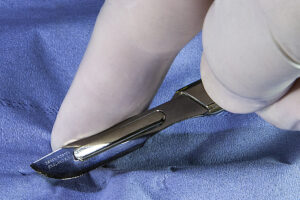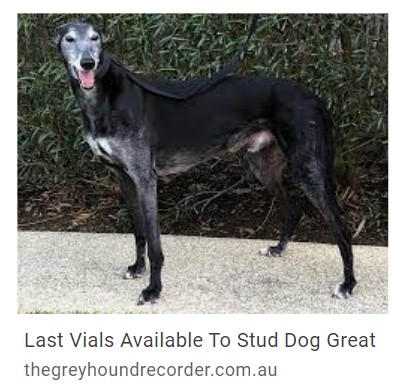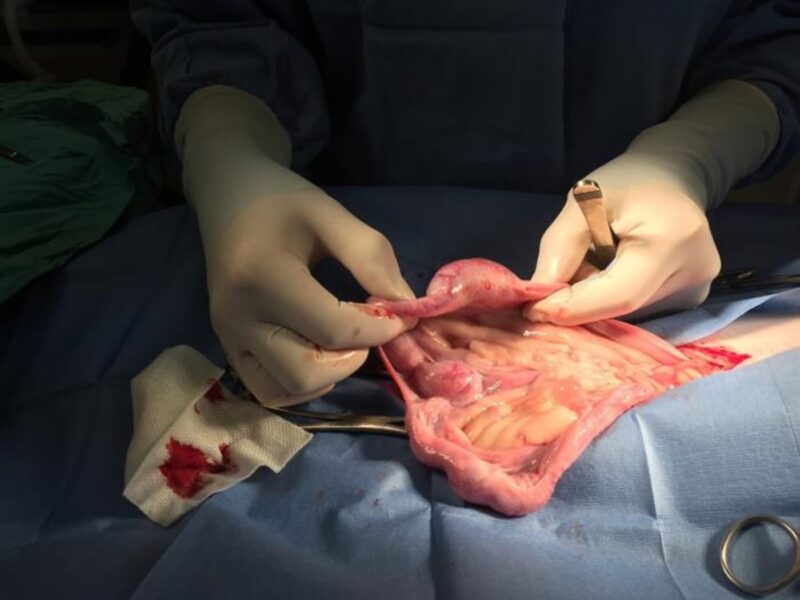SAI in progress with the uterus externalised so semen can be directly injected – photo credit –
Pleasant Valley Veterinary Services (above)
Surgical artificial insemination
Over 80% of greyhound breeding is done using surgical artificial insemination (SAI), an old fashioned and painful procedure which is no longer necessary.
- The image above shows SAI in progress with the uterine horns temporarily removed outside the body, so semen can be directly injected.
- The RSPCA says – “Surgical AI is highly invasive involving surgery and general anaesthesia and causes significant pain to the female dog.”
- The Australian Veterinary Association policy on SAI says – “Surgical artificial insemination (AI) must not be performed in dogs. Welfare considerations indicate that only non-surgical artificial insemination may be performed… reports have illustrated that the fertility of TCI is the same as, or better than, surgical AI in the dog, especially when using frozen–thawed semen…All states and territories in Australia should adopt the prohibition of surgical AI in dogs, in their respective Animal Welfare Acts.”

In late 2022, the Australian Veterinary Association issued its policy against SAI which said – “All states and territories in Australia should adopt the prohibition of surgical AI in dogs, in their respective Animal Welfare Acts…Veterinarians should phase-out the use of surgical AI by 1 January 2024.”
So far, no state or territory government in Australia has announced it will act on this recommendation.
Why is SAI problematic?
The reasons for surgical AI being prohibited are obvious and well documented.
SAI requires an incision into the abdomen through all muscle layers to allow semen to be injected directly into the uterine horns of a female dog. The female dog must then carry pups to full term while healing. Given this, SAI is unjustifiable ethically.
SAI also requires general anaesthesia which adds the risks of delayed wound healing and infection. Further, greyhounds are often at slightly more risk for general anaesthetic than most other dog breeds, as the anaesthetic effects last longer.
Greyhounds are also at a greater risk of blood clotting failure if there’s a minor surgical bleed related to the procedure. This is due to a breed-related tendency to break down clots quickly in the body.
“We do not recommend surgical insemination, nor do we perform this insemination technique at CSU. This technique involves a general anesthetic and surgery with associated risks … Further, surgical insemination does not increase conception rates or litter sizes.” – Colorado State University.
What are the more modern alternatives?
Instead of SAI, many specialists in veterinary reproduction advocate for transcervical insemination (TCI) as the most effective way of inseminating a greyhound. TCI is used worldwide and occurs via a vaginal and cervical catheter. In a study by Hollinshead et al, only seven of 1,103 intrauterine inseminations were not possible via TCI.
The Monash Veterinary Clinic, one of the biggest reproductive veterinary clinics in Victoria, says: “TCI is as close as we can get to a natural mating artificially”. Studies undertaken at Monash show “a greater success rate by more than 20% with the use of transcervical insemination of frozen thawed semen compared to surgical insemination”.
Even the dog racing industry itself recognises that “done by an experienced and proficient person, this method can be completed quite quickly, and the results are better than or equal to the surgical method”.

Why does the dog racing industry persist with SAI?
The dog racing industry refers to SAI as FSI (frozen semen insemination).
Older racing dog owners are in the long term habit of using this method and believe it’s superior to better alternatives, even though science says the opposite. Also, there are a small number of similarly aged vets who make a living out of SAI and don’t wish to upgrade their equipment or skills.
Read here about how a former NSW Minister for Agriculture bowed to the demands of the racing industry and ignored science.
Incredibly, the national industry body – Greyhounds Australasia – offers no guidance to its members regarding SAI by way of its national rules.
For more on ending surgical artificial insemination :-https://australianracinggreyhound.com/news/the-end-to-surgical-artificial-insemination-a-load-of-crap/127714/
What are the risks of the global trade in greyhound semen?
The demand for frozen semen has spawned a huge international industry.
This industry exists despite biosecurity concerns raised in the EU about the risks of the unregulated frozen semen trade spreading disease agents or genetic diseases from one country to another. Indeed, “diseases may be transmitted via AI, given that some organisms may infect the male reproductive system and may pass into semen”.
The bottom line is always that ‘money talks’. Dog racing participants will pay large sums of money for champion dogs and hence want to buy their frozen sperm (and use SAI in the often mistaken belief that it results in larger litters).
In late 2021, the last 10 vials of semen from a champion Australian stud dog were offered for sale at $14,000 per vial. Sadly, some sellers of greyhound semen actually require the use of SAI if dog racing participants wish to seek a refund as a result of their dog not becoming pregnant after being inseminated. This is evident in the terms and conditions listed on their websites.
Just as a ban on SAI in Australia is urgent, so too the trade in greyhound semen requires government regulation to force the market to be ethical in its approach to greyhound insemination.

- January 17, 2023 – Guardian Australia Painful and invasive racing greyhound breeding technique should be banned, vets say Tory Shepherd Vets want an invasive and painful greyhound breeding technique, which involves removing the uterus, banned across Australia. About 80% of racing greyhounds in NSW are bred using surgical artificial insemination. The Australian Veterinary Association has released a new policy declaring surgical artificial insemination (SAI) “must not be performed in dogs”.
- October 23, 2022 – Australian Dog Lover, Coalition for the Protection of Greyhounds (AUS)
Surgical artificial insemination of dogs is an animal welfare issue
Lina Yordanova
The NSW government has decided to overturn the proposed ban on a painful procedure that is outlawed overseas and not recommended in Australia by the RSPCA. Surgical artificial insemination (SAI) is used to impregnate dogs through a painful and potentially dangerous surgical process. The risks and discomfort associated with undertaking surgical artificial insemination are unnecessary with trans-cervical artificial insemination now available.
Images
Top: Pleasant Valley Vet Services, Surgical Insemination
Collage: Animal Liberation Queensland (top left), RSPCA SA (top right), Farm Transparency Project, (bottom left and right)
